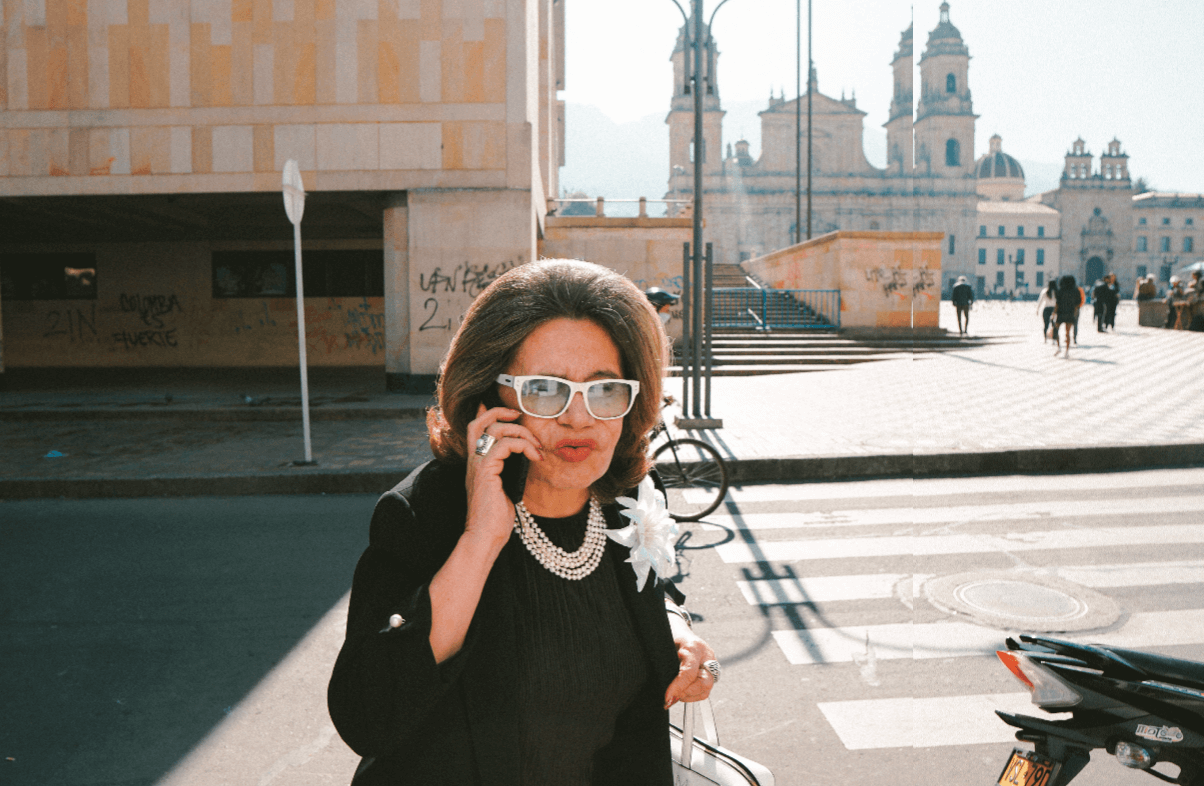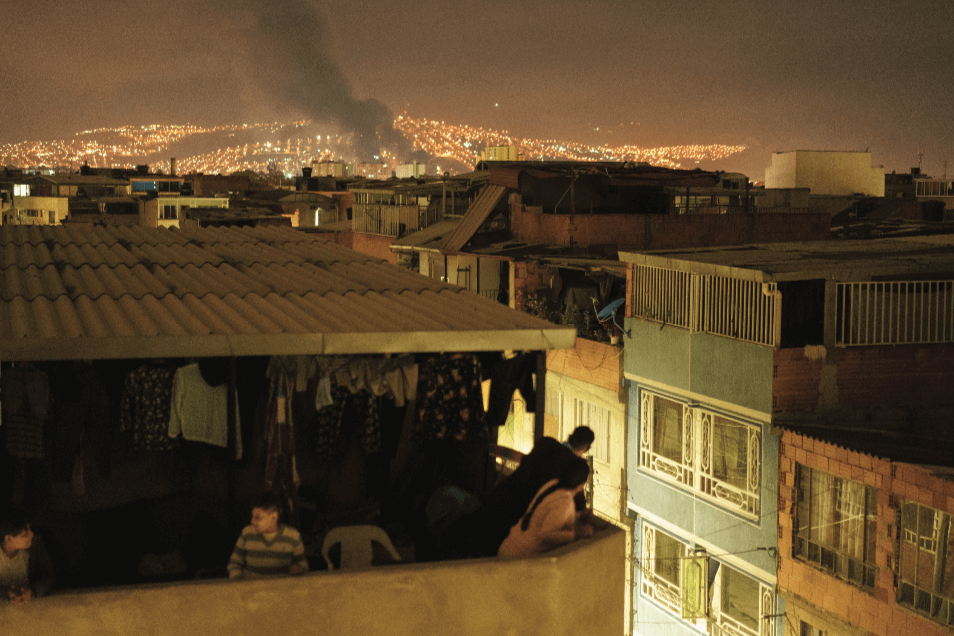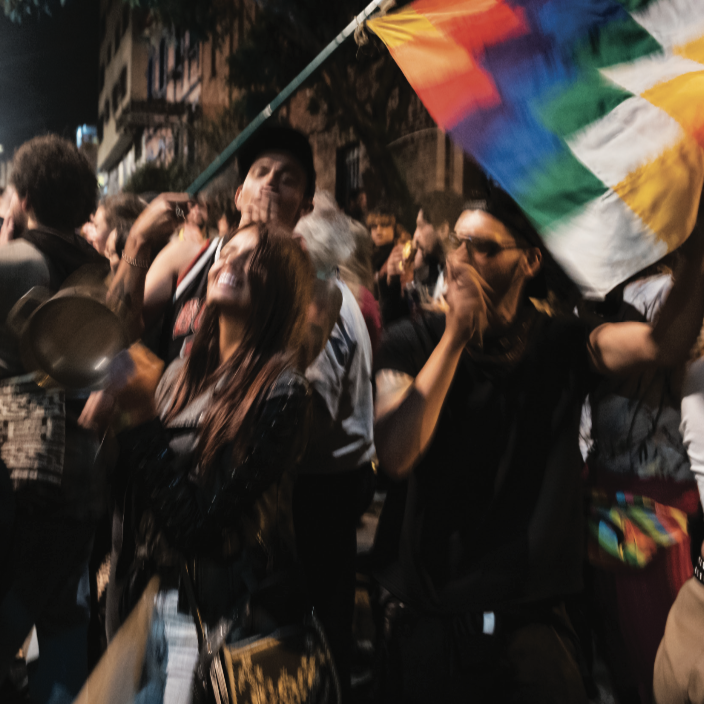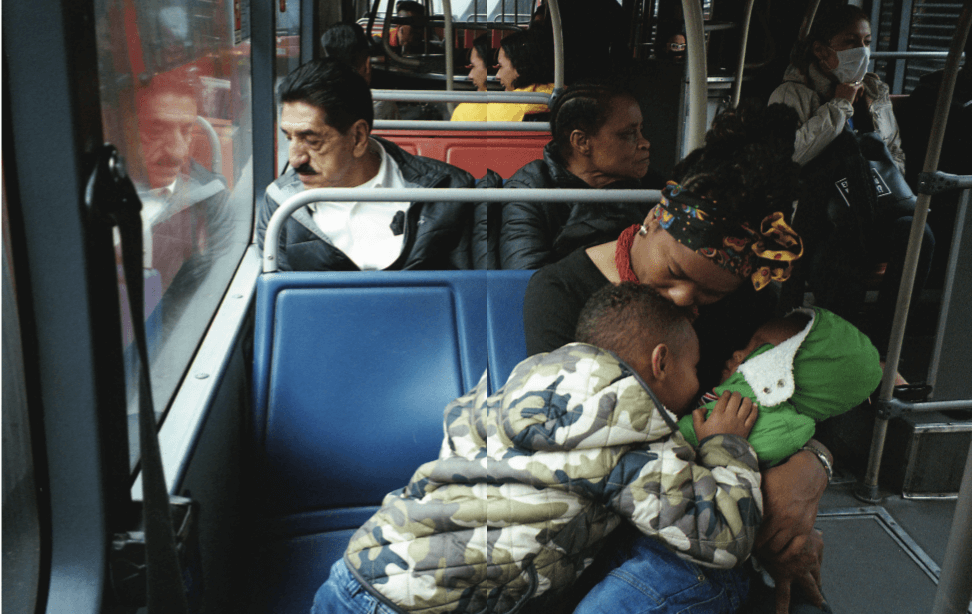
We are publishing this essay on contemporary Bogotá alongside a mid-century portrait of the city written by Gabriel García Márquez never before translated into English. Read the accompanying piece here.
The onces are never ready without the uva pasas bread from the local panadería. We all got them from our favorite bakery spot—the one our grandmothers call every other day to deliver Coca-Cola and Marlboros while getting an update on the neighborhood chisme—and the señorita who answers the telephone on the other side recognizes this with a buenas tardes, señora Mayi! How is your mami doing? In our case, Pecos Pan. In our case, puro puro barrio Cedritos.
It is 5PM, and the hijuemadre filo, the intense hunger eating at our insides, is driving the matriarchy seated around the dining table cucu. When the buzzer finally rings, all the tías celebrate, ashing their cigarettes in unison: ay ay por fin! Dígale que suba! Dígale que suba! And after the señorito delivery boy leaves, the apartment swells with the smell of freshly baked bread, chocolatico and campesino cheese. Las onces— the most loved, the most hated, the moment on Saturday afternoons at the abuela’s apartment where we eat guava roscón with our bare hands and brace ourselves to face the Tía Eye. The circle of tías digging nails first into the pandeyucas while disapprovingly reading your disheveled teenage ass. Because you wear bell bottoms with holes in them and they believe it is ay so low class, mija. Because they all have opinions on your outfit that are mumbled as they dip the almojábana in the chocolate, as they fish for the melted campesino cheese with a spoon. Because a niña que se respete, a girl who respects and loves herself, is always punto en blanco. Spotless.
The onces are legendary afternoons of cuchicheo, of family love and family shade. The obligatory smiles and forced kisses on everyone’s cheeks. Of abuela, a.k.a head matrona número uno, yelling all the way from the kitchen, injecting herself in every conversation while churning the jug of warm chocolatico shimmering on the stove, every so often coming out exasperated from the kitchen whispering blessings to herself—loud enough for all of us to hear—asking Diosito for fuerza because she has not stopped working all day and would you look at her hands? Por Dios. Our onces, our bonding time. Time that stretches into the night, essential afternoon hours that solidify the backbone of a true Colombian family: its labyrinth of secrets. Inevitably, someone will bring up the current political situation and the conversation will turn silent, the air thick like jello….

All over the neighborhood, arms are sticking out the windows, banging pots and pans with wooden spoons. Look up: A wave of sound overtakes the streets, an orchestra of protest. The famous, our famous, cacerolazo. Kitchen sets turn pachanga of resistance. Y aquí viene, the tucu tucu sensacional, the bum bum of the wooden spoon against the pans which fried arepas and huevos pericos that morning but right now start the oleada of sound at the Plaza de Bolivar, the very heart of our city. The collective effervescence quickly expands, the bum bum overtaking the entire séptima, rushing to the north, the west, the south. Cuchara’e palo y dele que dele. The banging is heard from afar, a dotted sound from over the horizon until it overwhelms your own building and there you are, swimming in it, arm sticking out, pounding in unison with your vecinos. The entire city palpitates together. We want change. We want protections for our social leaders. We want the government to stop killing the campesinos who work our land, feed our families. We want the rich to eat their paramilitary shit and stop electing their buddies and families to the presidency. We want young people to thrive. The heart of Bogotá pulsates with every flush of sound and at the Parque Nacional, blocking the artery that is the séptima avenue, the cacerolazo opens to an endless crowd of young people holding protest signs, peace flags, queer flags, feminist flags. There has to be thousands of us here banging our pots to the rhythms of cumbia. At the very heart of the park, next to the floripondio trees with their trumpet-like white flowers, a group of students with tambores, flautas, guache, play la pollera colorá. A circumference of music surrounds them. Porque aquí se baila y se protesta, here we protest with our tumbao, with our son y son, our weapon is our collective voice, our collective rhythm.
Drops begin to fall; we look up. Per usual, here comes the afternoon Poseidon criollo to ruin our hair and further clog the veins of the city….

The other rain is coming, the one from our bodies. Here we are ready a sudar como perra. Sweat like a bitch. That’s goal, mi cielo. Entra cariño, sin compromiso. The small concert venue where trap, dembow and reggaetón will exorcize our bodies awaits inside. Outside: Circles of queer kids showcasing their best fashions: faux fur coats on mesh ombligueras, pink sun-glasses held by a rhinestone chain, hologram platforms and fuchsia braids. Cigarettes on every hand bought from the seño with her stand. The night is a Bogotá night, which is to say cold, which is to say foggy, which is to say the smoke is both cigarette and lung. Tiny lace crop-tops because we’re used to freezing our ass outside while looking damn good. The shade here is palpable, thick. We’re here to be seen. Long fake eyelashes roll, lips purse, fingers snap. Our biggest weapon is the cut-throat criolla stare. Over the years, Bogotá has trained our eyes to crush any mosquita muerta with a look. Up and down we eye you. We see you. Honey, this is the queer underground queendom of reggaetón, where twerking to Ms. Nina meets aguardiente meets boys blowing each other in the bathroom meets sweaty pools of glittery bodies grinding on each other. The dance floor is our runway, the night our hiding cloak. The show opens with a boy in pink cowboy fringe shimmying shoulders, vibrating ass, voguing to reggaetón and merengue, shooting at us with a fake pink pistol. Bum bum! We die in each other’s arms. We leave it all on the dancefloor. Nobody here represents a gender. If there is any notion of gender is that it is dead, cariño, so grab a pair of pumps and serve your best Friki Criolla Realness: Boys with purple beards and pierced bellybuttons. Shaved-head girls in pink cat-eye sunglasses, skull-shaped pasties. This, our getaway from the Sociedad Bogotana, from the Dios te salve Marías, the violence of expectations. The night and its creatures. Here, we are free….
And there it is: the emerald green cerros promising rain. The dark nimbus clouds one grey wig dressing the monumental eastern mountains with their phantasmagorical fog. The cordillera like an old drag queen with a messy dry weave. An old forest queen about to cry tears of hail into her city. That chaotic monster who, every other day, turns Bogotá into impressionistic strokes of red and silver. Que va a llover. Que lo que viene es un palo de agua. If there’s a constant in our city, it is the rain, the puddles, the señoritas in taconcito and miniskirts with plastic bags over their heads running from buseta to buseta, purses tightly clutched over their bellies like deformed babies. La Lluvia. One of Diosito’s third-world jokes: because we have no ocean, no mar azul, but an hijuemadre sky that rips open, our very own celestial water balloon, rushing like a waterfall into every crevice so that the señorito from the local tienda runs inside the store placing buckets under every leak. The rain is tucu tucu against windows, it is bumper-to-bumper traffic and puddles that are more like swimming pools where cars and motorcycles find their demise. The rain is conversation, is decision on whether or not we’re taking that umbrella, that paraguas, to the reggaetón party as we hail an Uber, an illegal Uber, and do not sit in the back but in front so the cops won’t stop us, as we sit tight and rollercoaster the circunvalar avenue to land in the Chapi hood. Chapinero. Chapigay….

Y ahí viene el bus. Hailing it with the manito. There are a few ways to get around in Bogotá: taxi, bici, car, buseta, bus and transmi. Transmilenio, or Transmi, is our subway criollo on wheels. Back in the days, the busetas used to be boxed theatres: long darkened vehicles with purple-draped dusty curtains, a Virgen del Carmen stickered on the bus driver cabin and a sa sa sa over the speakers deleitándonos with the latest vallenato. One would hustle the bus-driver—seated in front with wife, son and daughter sipping tintico, maneuvering the wheel bigger than him, always jolting backwards when clutching— pay half the price and off the dusty box went, whispering its vallenato rhythms, sometimes so packed that some of us held to the door railing, half inside, half outside, rollercoastering down the Boyacá or the Séptima or the Jiménez avenue. Hola Hola welcome to our rush hour cachaco, all of us sanochaos in that bus. Clutching purses and backpacks for dear life. Now, the busetas are rare and the buses are like in every big city: organized, sterilized, a tap of a rechargeable card gets you in y vámonos. There we are, watching red brick building after red brick building open up, fresno trees framing the street, the bumper-to-bumper traffic so intrinsic to Bogotá, the honking our background music, the potholes so deeply carved into our bones, it is in our DNA, part of our identity. The clogged arteries of the city are our clock. How we mark time. Now, the afternoon sun breaks into geometric shadows on all of those faces sound asleep, heads resting on windows. And outside the bus: el barrio. The many hearts of La City: Teusaquillo, Chapinero, Usaquén. The neighborhood with its tiny park, small church, a few old men on a bench, newspapers on their laps. On the wall behind the church, FURIA FEMINISTA spray-painted in cursive. Punk kids in choker chains and dark eyeliner smoking under the sauco tree. Señoras in full rulo realness checking the ripeness of avocados on the fruit stand in the corner. Then the labyrinth of hair salons advertising the lowest blow-dried prices and always a señorita hairstylist in an apron outside seated on a plastic white chair, smoking a cigarette, filing her nails. The best pollo place, the best hamburger place. The place where with your primos you get juguito de mora en leche. Mora juice, mandarina juice. Y siempre the altiplando cundiboyacense as our backdrop, the sabana cradling our bodies. Underneath the paved cement, the history of our home whispers its violence as the wheels of the bus continue: Bogotá is Muisca, Bogotá is indigenous land.
Contributor
Juli Delgado Lopera is an award-winning Colombian writer based in San Francisco. They are the author of the New York Times-acclaimed novel Fiebre Tropical (The Feminist Press, 2020). Juli is the former executive director of RADAR Productions, a queer literary non-profit in San Francisco.




